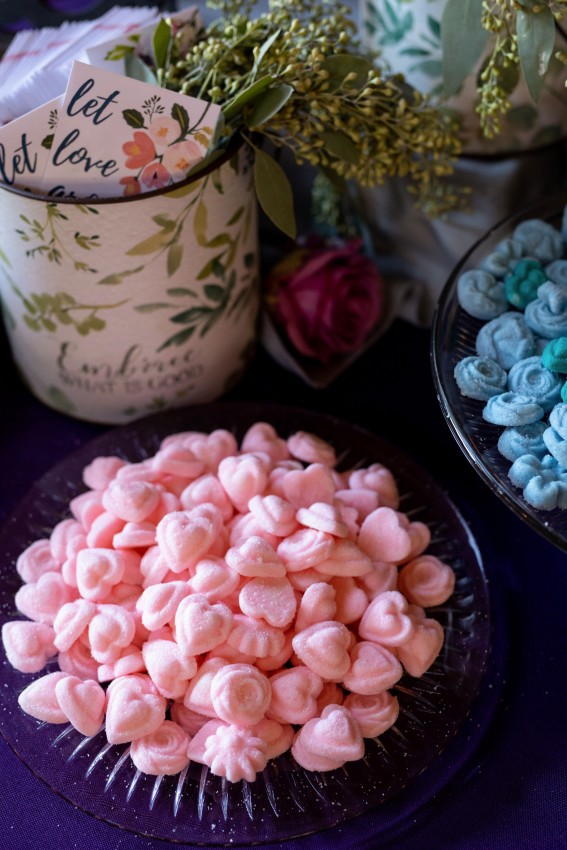Beginners Guide: Wedding Cake Terms
Cakes are easier than dresses when it comes to terminology, but there are still some things you should know. Let us help you with the basics.
For most of us, the only professional baking experience we have is binge watching The Great British Bake Off while eating cake. So navigating the process of finding a wedding cake can be difficult. Refer to this baker-to-English translation guide to help you get your perfect wedding cake!
Icing Options
The icing determines the look and style of your cake, but who knew there were so many kinds? The biggest thing to know is what kind of icing will hold up if you're having an outdoor wedding, or what kinds you'll be limited to if you have an intricate design in mind.
Buttercream: The classic frosting used on most cakes, this is a smooth icing that can be made in different consistencies, colors, and flavors. It is used for add decorations and borders, cake writing, and as the frosting or filling. It will melt in extreme heat.
Crumb Coat: A thin layer of icing, put on before other layers, that catches crumbs. Naked cakes are made by using a crumb coat of icing and not adding more layers.
Fondant: A stiff cake covering that is used to give it a smooth and clean look. It is made of syrup, sugar, and gelatin. Fondant is not as tasty as other icings, so many couples choose to have a layer of buttercream or ganache under the fondant. It doesn't need to be refrigerated, so it's perfect for outdoor weddings!
Ganache: A rich chocolate icing that gives the cakes a glossy finish. It can also be used as filling. It will melt in hot or humid weather.
Marzipan: A paste with similar consistency to fondant made from almonds, eggs, and sugar. It can be used as the icing or molded to make cake decorations.
Royal: This icing dries hard and shiny, which makes it great for details on an elegant or glamorous cake design.
Cake Decorations
As you're looking through pictures of cakes for inspiration, you might love a certain look but aren't sure how to explain it to a baker. While taking a picture to your bakery is the easiest way to get the look you want, being able to discuss the details of the design using specific terms is helpful. Here are some common ones you'll find useful:
Edible Images: Images that can be imprinted on the cake using edible ink and edible frosting paper.
Floral Wire: Inedible wire that can be used to secure decorations.
Gold Leaf: Edible thin gold strips are applied to the outer layer of the cake to add a metallic flair.
Gum Paste/Sugar Paste: Made from gelatin, cornstarch, and sugar, this paste is used to mold decorations. It is edible but probably won’t taste the best.
Pearls: An edible decoration that is similar to hard candy. They resemble pearls and are used to decorate the outer layer of the cake.
Piping: A decorating technique that bakers use to add patterns, swirls, and lettering. It is usually used for basket weave, latticework, and shells.
Pulled Sugar: Used to mold decorations and is made by boiling sugar, water, and corn syrup together.
Decorating Techniques
Airbrushing: Coloring is sprayed onto the cake to add more interesting coloring to the icing.
Basket weave: A crosshatch pattern made to look like a basket pattern.
Chevron: A horizontal zigzag pattern added the cake using fondant.
Cornelli: A delicate, lace-like pattern made using an elaborate piping technique.
Damask: Geometric, animal, or botanical patterns usually made using fondant.
Marble: Used when the interior cake has multiple flavors, in which the flavors are swirled together.
Ombre: Shading that blends from one color into another, or through multiple shades.
Petal Dust: A dust like mixture that gives cake decorations deeper matte colors with a shine. It can be used to make cake decorations more realistic.
Swiss Dots: Small pearl-like dots piped on the outermost layer that resemble the Swiss dot pattern on wedding attire.
Other Things to Know
There are a few accessories that come with cakes you should know about, especially if you have your eye set on a more complicated or elaborate design. Some can be rented, such as pillars or fountains. Toppers offer a fun way to personalize your cake while having a memento to keep after your wedding.
Cake Topper: Decorations of the top-most layer of the cake. Generally refers to the figurine of the bride and groom, but can also be a monogram or picture.
Fountain: Miniature versions of a water fountain that add a bit of whimsy to your cake. Fountains are a trend that's making a comeback, and you'll see them used with pillars but usually only on larger, multi-tiered cakes.
Groom’s Cake: A specialty cake made with the groom in mind. Often it is themed around the groom's interests and served at the wedding reception on a table separate from the wedding cake.
Miniatures: Small individual wedding cakes served to each guest.
Pillars: Usually made of plastic and used as separators in a tiered cake.


